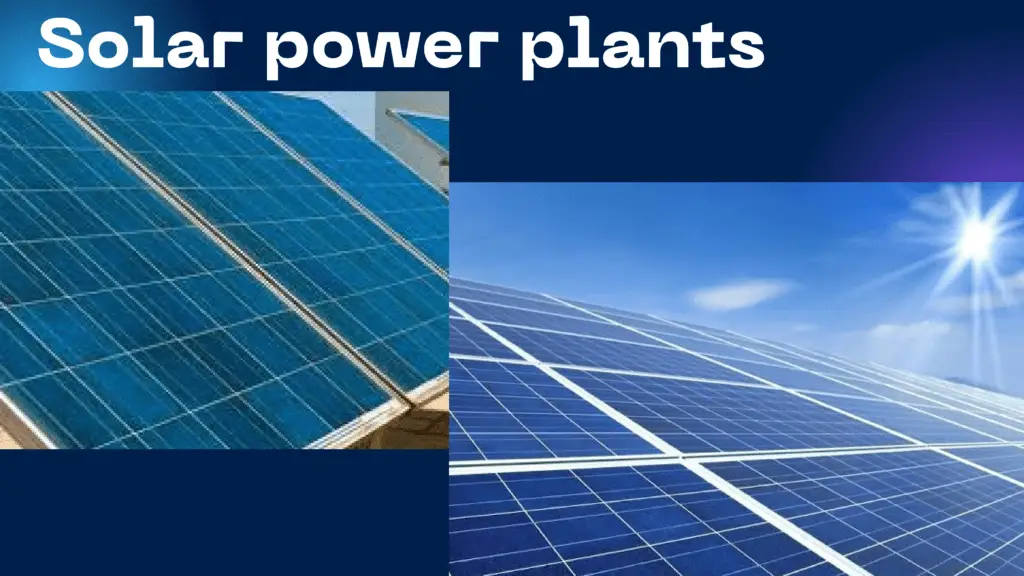Solar power plants in an era of growing concerns about climate change and the need for sustainable energy sources, solar power plants have emerged as a beacon of hope. By harnessing the sun’s abundant energy, these innovative facilities are transforming the way we generate electricity and mitigating our reliance on fossil fuels. In this article, we delve into the world of solar power plants, exploring their advantages, technological advancements, and the significant role they play in shaping a cleaner and more sustainable future.

Contents
Tapping into an Inexhaustible Resource:
It leverages the most abundant and readily available energy source on Earth: the sun. Every day, our planet receives an astounding amount of solar radiation, capable of meeting global energy demand several thousand times over. By capturing this energy using photovoltaic (PV) or concentrated solar power (CSP) technologies, solar power plants generate electricity without depleting finite resources or emitting harmful greenhouse gases.
Types of Solar Power Plants
Photovoltaic (PV) Solar Power Plants
These plants harness solar energy by using solar panels made of semiconductor materials to directly convert sunlight into electricity. They are widely deployed for their simplicity and efficiency, making them a popular choice for distributed energy generation.
Concentrated Solar Power (CSP) Plants
CSP plants concentrate sunlight onto a focal point using mirrors or lenses, generating high-temperature heat to drive turbines and produce electricity. They offer the advantage of energy storage, allowing power generation even when the sun is not shining.
Floating Solar Power Plants
Floating solar power plants are installed on bodies of water, such as lakes or reservoirs, offering benefits like reduced land use, minimized evaporation, and improved panel cooling, which can enhance energy production and efficiency.
Hybrid Solar Power Plants
These plants combine multiple renewable energy sources, typically solar and wind, to provide a more stable and reliable power supply. By integrating different technologies, they can balance energy generation and ensure a consistent energy supply.
Environmental Benefits:
It offers numerous environmental benefits. Firstly, they produce clean energy, releasing no harmful emissions or pollutants during operation. By displacing conventional power generation, they significantly reduce carbon dioxide emissions, helping combat climate change. Additionally, it has a smaller ecological footprint compared to fossil fuel-based power plants, mitigating the destruction of habitats and environmental degradation.
Scalability and Versatility:
It comes in various scales, ranging from small residential installations to massive utility-scale facilities. This scalability enables adaptability to different energy needs, from individual households to entire communities. Moreover, solar power plants can be deployed in diverse locations, including deserts, rooftops, and even floating arrays on water bodies, making efficient use of available space.
Technological Advancements:
The rapid progress in solar power technologies has paved the way for improved efficiency and cost-effectiveness. Innovations like thin-film solar cells, perovskite solar cells, and bifacial panels have enhanced energy conversion rates, expanded application possibilities, and reduced manufacturing expenses. Furthermore, advancements in energy storage systems, such as batteries, facilitate reliable electricity supply during periods of low solar irradiation.

Economic Opportunities:
The growing solar power sector offers substantial economic opportunities. It drives job creation in manufacturing, installation, operations, and maintenance. The industry’s expansion also stimulates local economies, attracts investments, and reduces dependence on costly imported fossil fuels. Additionally, it provides energy access to remote and underserved areas, empowering communities and driving sustainable development.
Overcoming Challenges:
While it has experienced remarkable growth, several challenges remain. The intermittency of solar energy necessitates reliable energy storage solutions and grid integration to ensure a steady power supply. Additionally, the initial investment costs, although declining, can still pose a barrier to widespread adoption. Governments, industries, and research institutions must collaborate to address these challenges and further promote solar power plant development.
Conclusion:
It exemplifies humanity’s capacity to harness and utilize sustainable energy sources to meet our growing electricity needs. With advancements in technology, economies of scale, and increasing public awareness about environmental concerns, solar power is poised to play an increasingly prominent role in our energy mix. By embracing it, we can transition towards a cleaner, more sustainable energy future, reducing greenhouse gas emissions and safeguarding our planet for generations to come.
